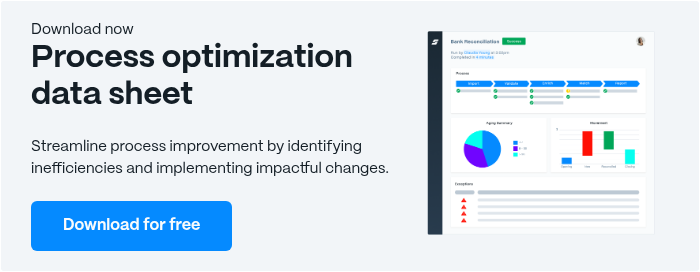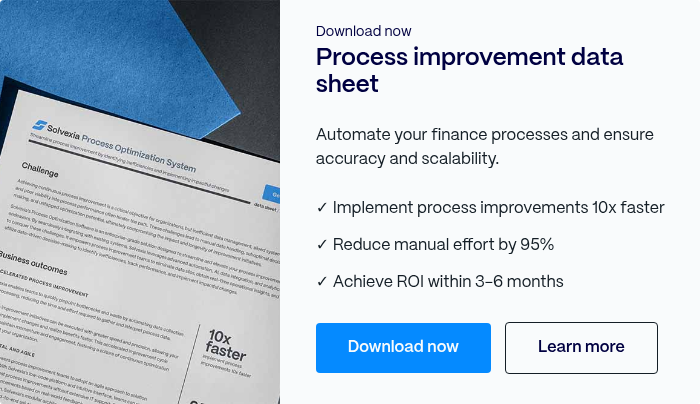11 Continuous Improvement Examples You Need to Know

There isn’t a business leader out there that would say no to being able to improve their business. In whatever capacity it may be, business improvements should be constant within an organization. A process called continuous improvement provides precisely this value. With a continuous improvement example, as well as techniques, this article will showcase how you can help your business operate better.
Business improvements not only benefit the bottom line, but they also improve quality, safety and both employee and customer satisfaction. 54% of continuous improvement enhancements increase customer satisfaction.
Whether you know what you need to improve or not, this article will provide you with everything you need to know about continuous improvement, as well as implementation examples that could greatly benefit your organization.
Table of Contents
1. What is Continuous Improvement?
2. What are the Types of Process Improvements?
3. 11 Continuous Improvement Examples
4. How to Create an Environment of Continuous Improvement?
5. Incremental vs. Breakthrough Continuous Improvement
6. Benefits of Continuous Improvement
7. How to Identify Areas for Continuous Improvement?
8. When to Look for a Continuous Process Improvement Tool?
9. What are Continuous Improvement Process Methodologies?
10. What are Continuous Improvement Metrics?
11. How to Implement Continuous Process Improvement?
12. How to Address Continuous Improvement Challenges with No-Code Tools?
13. How to Build a Continuous Improvement Culture with No-Code Tools?
What is Continuous Improvement?
First things first, let’s define what continuous improvement means. With its roots in manufacturing, continuous improvement is a method that strives to locate opportunities for ensuring efficiency, continuously. This involves the assessment of current processes, products and services to ensure that output is maximized and waste is minimized.
Continuous improvement benefits internal and external stakeholders, from employees to customers and investors alike. But, continuous improvement isn’t a one-and-done deal that a company performs and then forgets. If the name doesn’t give it away, let’s drive this fact home - the method is continuous, as in, it does not have an end. It’s a method that becomes a part of a business’ ongoing operations. You can consider it to be like a way of life, rather than something new you might try once. But, even though it becomes a part of your business, it still requires strategy and methodology to impact change.
Since continuous improvement becomes a way of operating, this means that everyone must be on board. So, creating a culture of improvement is a priority to make it work. This can be done by empowering everyone within an organization to understand that they can point out places for development to spark positive change.
Types of Process Improvement
There are various methods for process improvement. We’ll briefly define three kinds and then move into examples of continuous improvement.
- LEAN Technology: Created by Toyota to optimize its production cycle, LEAN improvement is customer-focused. It defines what customers value from the process most to determine what can be eliminated from the production of a product to decrease waste and cut costs.
- Six Sigma: Six Sigma is a method that focuses on improving the quality of business processes. It’s aimed at limiting the variation in processes to ensure consistency and increase performance. It uses statistics to measure deviations from a defined centre line on a control chart.
- Total Quality Management: With some similarity to Six Sigma, Total Quality Management (TCM) holds all involved parties responsible for producing quality outputs. It looks to standardize processes to reduce errors.

11 Continuous Improvement Examples
Now that you understand what continuous process improvement is, it’ll be helpful to see the theory applied in a business setting.
Here’s a look at eleven examples of continuous process improvement and where you can use it during your day-to-day practices:
1. Ideation and Think Tanks:
Initiating regular think tanks and ideation sessions can benefit your organization. You can choose to run think tanks with an agenda in mind or at the very least, elicit the attendance of key personnel so that valuable ideas are discussed. During these sessions, you can explain how processes are currently being run to see if there are places that need to be improved and changes to be made. Often, since technology is so intertwined with most business processes, a starting point is to discuss updates and new technology solutions geared towards optimization. For example, automation solutions are becoming increasingly necessary for businesses to remain competitive.
2. Surveys and Polls:
The people who work within your organization are the most well-versed to know where improvements can be made. It’s not only important to gain feedback from customers and vendors, but important and often overlooked is employee feedback. By polling your team, you can find out their pain points and find places for improvement. As a business leader, you spend most of your time on the big picture, so the smaller details that significantly affect your business’ outputs can go unnoticed without such insight.
3. Monthly Training:
In big businesses, especially, it is common that each employee works within a silo or “swim lane.” But, both cross-training and automation software can contribute to process improvement. For example, if you can train employees to know how to do multiple jobs, then if someone is absent because of sickness or vacation, a process remains unharmed. Another idea is to implement an automation tool within your organization to reduce dependency on key personnel. For example, automation tools like Solvexia’s system are designed such that processes are stored within the system and can be run by virtually anyone with access. Not only is the process stored and will automatically run, but as the process runs, the system documents the steps it is taking to produce its output.
4. Time Audits:
One of the most significant resources wasted within a business is time. Being able to accurately measure and gauge how much time a process takes on behalf of your employees can offer insight into where you can optimize a process. It’s as simple as using software to time a process. Then, you can analyze how long processes take and find ways to eliminate wasted time. This could be in the form of automating approvals and reducing touch-points, thereby preventing potential bottlenecks and delays from occurring.
5. Catchball:
Within organizations, processes are rarely started and completed by a single person. As such, every process needs to have someone who can be held responsible for its execution, but still requires the input and assistance of multiple people. Catchball is a method of continuous improvement that requires the person who initiated a process to state its purpose and concerns to the others involved clearly. In this way, they can then “throw” it out to the group for feedback and ideas for improvement, yet the single person remains responsible for its completion.
The above are just some ideas to get continuous improvement going within your organization.
Here’s a look at some areas that breed waste within the business that often have room for improvement:
- Timeliness: System downtimes, approvals and bottlenecks of information
- Errors: Manual data entry errors, invoice errors
- People: Underutilized workforce, excessive management and micromanagement
- Production: Overproduction of printed documents before necessary
All of the above are just baseline examples of what many businesses face. In every case, an automation tool like Solvexia can assist in eliminating waste and helping with continuous improvement. The automation tool is designed to be accessible to all relevant parties, and by automating data and processes, errors are inherently reduced.
6. Improving Environments:
While you may be focused on operations and productivity levels, it’s easy to overlook the environment in which your team works. However, if you’re able to implement changes to better the environment, it can improve productivity, too. For example, you can touch up interior design, add green landscaping, and adjust lighting.
7. Information Technology:
Another example of continuous improvement is adding new software and technological tools that can aid workflows. For example, if you were to implement Solvexia in your workplace, you could witness 98% gains in productivity with automation solutions.
8. Staff Training:
No matter how experienced your staff is, one of the most valuable continuous improvement activities is to grant a refresh on staff training. Things change, so it’s a great way to keep everyone up-to-date with skills and knowledge.
9. Edit Work:
Of the many process improvement examples out there, you likely take part of want to implement editing your team’s work. From editing to QAing, this straightforward addition to your daily activities is bound to make a world of positive difference.
10. Stand-Ups:
Stand-ups are a wonderful way to ensure everyone is involved and heard. They are open forums for discussion for everyone in your organization to air their pain points, discuss their projects, and ask for needed support.
11. Optimizing a Process:
Businesses are filled with processes, and there is usually a way to reduce waste and enhance efficiency within a process. For example, if you’re surveying customers for product development but find that their answers are vague, you may update your surveying process to checkbox answers rather than open-ended responses.
How to Create an Environment of Continuous Improvement?
With the examples in mind, you’re on you way to implementing continuous improvement. But, before you get going, be sure to set your workplace environment up for success. In order to do so, it’s recommended to:
1. Involve Everyone
Every person that is part of your organization is of great value to how your operations run. As such, they should all be included in the continuous improvement process. It’s a combined effort and only works well as one that is inclusive.
2. Positively Encourage
Fear-mongering isn’t the way to go when you’re trying to drive positive change. Instead, encouragement goes a long way. Offer support to anyone who needs it and be sure to praise changes, no matter how big or small.
3. Openly Communicate
When you’re including everyone, a major key is to clearly communicate. This aids in developing a transparent culture in which all people are on board for the ride.

Incremental vs Breakthrough Continuous Improvement
Continuous improvement can be made as you go or a full-fledged approach to tackle significant issues at once:
Incremental Continuous Improvement:
This type of process improvement is done as you recognize problems during a process. The upside of this type of improvement is that it is relatively cheaper and faster than breakthrough continuous improvement. Say you are running a process and notice a mistake. This could be a typo in a brochure or an error in data. You can fix the error as you go; however, to ensure that the actual process moves forward in its next iteration without the same error requires that you communicate the change. So, incremental continuous improvement is beneficial so long as the person who fixes the mistake brings it up to the rest of the organization.
Breakthrough Continuous Improvement:
Breakthrough continuous improvement happens the other way around. Rather than making a change during the process itself, it involves targeting the process for improvement and then strategically approaching the change as a united front. These are typically more substantial items for correction that require an entire team to implement.
Benefits of Continuous Improvement
Continuous improvement offers a wide range of advantages that positively impact various aspects of an organization. Here are the key benefits:
1. Streamline workflow:
Most processes require multiple touchpoints or parties involved. These always have room for improvement. Whether it’s from the basis of the data needed or the communication between the people who play a role in its completion.
2. Reduce costs/waste:
Project managers and executives have models and data to review the cost of every project. With continuous process improvement, they can assess where the fees are too high and then work towards reducing costs and waste to make a process more efficient.
3. Risk Proofing:
Continuous improvement helps to spot issues before they grow larger. Spotting opportunities for improvement early on can help to reduce risks in the future.
4. Improved Morale:
By practicing process improvement, employees are engaged and empowered to make a positive difference in the company. This makes them feel more valued, happy, and motivated overall.
5. Quality:
The ultimate goal of any business is to deliver value to customers. By improving processes, you are also improving the outcome of said processes. As a result, there’s a strong likelihood that you’ll enhance the quality of goods or services, which tends to drive customer loyalty.
How to Identify Areas for Continuous Improvement?
When approaching continuous improvement, a comment question is where to begin and how to know what is ripe for improvement. There are a few ways to identify areas, including:
1. Feedback
Leverage the feedback of your employees through surveys, chats, meetings, or suggestion boxes. By doing so, you get those who are on the ground and in the weeds to share their experiences and shine a spotlight on processes that could use attention.
2. Process Mapping
Another useful way to identify processes that need some love is to visually map out workflows using process mapping. By seeing the steps and pieces that make a process flow, it’s easier to notice where delays or redundant steps may be occurring.
3. Analytics
Leveraging automation software with access to analytics means that you have KPIs and metrics displayed in a visual dashboard to track trends and patterns. If you notice outliers, it may be a sign that it’s time to review those processes.
When to Look for a Continuous Process Improvement Tool?
It’s safe to say that it’s always a good time to search for continuous process improvement tools. However, there are tell tale signs that elicit the true need for process improvement, such as:
1. Quality Challenges
If you notice that there are constant customer complaints about a specific product’s quality or service, it’s likely that it’s in need of adjustments.
2. Bottlenecks
Noticing that workflows get stuck somewhere in the middle? Inefficiencies and delays are undesirable outcomes, so if they are creeping in your business, it’s time to take notice.
3. Growth
Perhaps things are going very well, and you’re not experiencing either of the above. Instead, you’re scaling and growing your business because of positive outcomes.
Well, this is another good time to consider using a continuous process improvement tool because as you expand, you want to ensure the quality is unaffected and that your business can keep up with increased demand.
What are Continuous Improvement Process Methodologies?
There are plenty of process improvement methodologies to apply in your business. Here is a look at some of the most popular practices to use for your own continuous improvement examples:
1. PDCA
PDCA is an acronym for: Plan, Do, Check, Act. Also known as the Deming Cycle, PDCA attempts to collect knowledge about a process in order to make it better.
- Plan: Create a hypothesis for why the problem exists and potential solutions.
- Do: Implement the solutions.
- Check: Examine how your new solution has impacted the outcome.
- Act: If the results are better, then scale the solution. If there’s still room for improvement, then return back to step one to try again.
2. 5 Why’s
This one may remind you of that stage when a toddler can only ask, “Why?” but there’s an actual reason to do so. The 5 Why’s is an attempt at root cause analysis, or to uncover the reason why a process may be inefficient.
It’s as simple as it sounds – you ask “Why?” five times to keep diving deeper into the heart of a problem. By leveraging perspective, you can uncover a lot.
3. Kanban Boards
For visual learners, Kanban Boards offer a way to see how processes flow visually. By doing so, it may be easier to pinpoint inefficiencies and make edits to the troublesome aspect of a process.
What are Continuous Improvement Metrics?
How do you know that your continuous process improvement efforts aren’t being done in vain? Through the use of metrics, of course!
When it comes to continuous process improvement, the following metrics are worth keeping track of:
1. Cost
Cost is an indicator of your business’ overall health and strategy. You can see how much you’re spending on labor, inventory, materials, and your team’s time. Hopefully, when you properly improve upon a process, you can cut costs as a result.
2. Customer Satisfaction
Another way to gauge the outcome of your actions is to measure customer satisfaction before and after the changes have been made. Consistent customer surveys and requests for feedback/reviews can show you how your business is performing.
3. Safety
Another prime concern for any business is the safety of its people. Tracking safety, such as the number of incidents in a certain time period, can provide insight into operations. The more a company prioritizes safety, the more employees feel that they can trust their employer, as well.
How to Implement Continuous Process Improvement?
As mentioned above, continuous process improvement doesn’t always have a clear beginning and end. Instead, it works best when it is part of the company culture and involves everyone within an organization.
Here are some considerations for how to make continuous process improvement the norm within your business:
1. Have a Vision
Start by defining objectives and goals clearly. By communicating these goals within your organization, you can ensure that everyone is aligned and on the same page to promote better end results.
2. Define Measurable Goals
SMART goals are always recommended so that you can assess outcomes. SMART stands for: specific, measurable, achievable, relevant, and time-bound.
3. Leverage Data
Say goodbye to guesswork by utilizing data and analytics for quantifiable information. By analyzing data, you can also spot trends and patterns that can signal where your next process improvement efforts must reside.
4. Train Employees
Change isn’t always easy. It’s vital to train and support employees as you make any adjustments to existing processes. This is especially true when you implement new technologies and want your employees to make use of such tools. They should feel comfortable using new technologies as part of their processes and routines.
5. Manageable improvements
Set reasonable goals. When setting out for improvement, you want to break down larger projects into smaller, measurable pieces. This will help to reduce overwhelm, as well as keep everyone involved on the right track to succeed.
6. Elicit Feedback
You should continuously seek feedback from customers, stakeholders and employees throughout your operations. This feedback will not only help locate opportunities for improvement, but it can also offer new perspectives and breed new ideas.
7. Motivate employees
Not only should you breed a culture where each employee feels empowered to notice inefficiencies and offer solutions, but you should also develop a rewarding culture to be motivational. For example, you can create rewards or develop an accessible system for employees to share feedback continuously.
How to Address Continuous Improvement Challenges with No-Code Tools?
As mentioned above, there may be resistance to using no-code tools or new technologies within your business, especially when it comes to its application for continuous improvement examples.
To overcome these challenges, it can be beneficial to:
1. Communicate Openly
The most important thing you can do when introducing anything new into your business is to communicate with your employees as to the reason why. By clearly communicating the need for process improvement and process improvement tools, you can help to reduce fear and actually spark interest/ support.
2. Proof-of-Concept (POCs)
Rather than starting with widespread alterations, you can begin with a proof-of-concept project. For example, if there are multiple processes you wish to amend, start with one.
Then, you can use it as an example as to how the no-code tool has not only improved the organization, but also the lives of employees, too. When employees experience the benefits first-hand, they will be more willing to take part in widespread changes.
3. Training
We’ve touched on it briefly already, but adequate training and support is another critical way to overcome challenges associated with implementing new technologies. When people feel comfortable using a technology, then they are naturally more likely to use it!
No code tools, like Solvexia, can be used to automate many of your primary finance functions. Once set up, Solvexia requires no extra support from IT teams and is easy to use with drag-and-drop functionality.
Companies can leverage Solvexia to automate processes, including: expense management, reconciliation, rebate management, commissions calculations, regulatory reporting, and more.
How to Build a Continuous Improvement Culture with No-Code Tools?
Continuous improvement is an ongoing effort, hence the word “continuous.” And, when you’re using no code tools to assist, it’s critical to foster a culture that is in support.
Here’s how you can better support your team to support continuous improvement:
- Recognition: Openly recognize those who are helping to support continuous process improvement efforts.
- Gamification: Create leaderboards and make it like a game to reward those individuals and teams that contribute the most.
- Collaboration: Enable employees to share best practices and recommendations with one another.
The Bottom Line
Continuous process improvement offers a method for your business to get better at any point in time. Whether you choose to implement incremental or breakthrough changes or a mixture of both, you can help to reduce waste and optimize outcomes. The above continuous improvement examples and strategies can help you achieve your business goals.
Like any type of process improvement, you want to remember to track and monitor any changes to ensure you are following towards improvement, rather than hurting any other part of the process. Automation software like Solvexia can help to analyze current processes, as well as implement solutions that optimize operations.
FAQ
Intelligent reconciliation solution
Intelligent rebate management solution
Intelligent financial automation solution
Intelligent Financial Automation Solution
Intelligent financial automation solution
Intelligent financial automation solution
Intelligent financial automation solution
Intelligent financial automation solution
Intelligent regulatory reporting solution
Free up time and reduce errors
Recommended for you

Request a Demo
Book a 30-minute call to see how our intelligent software can give you more insights and control over your data and reporting.

Reconciliation Data Sheet
Download our data sheet to learn how to automate your reconciliations for increased accuracy, speed and control.

Regulatory Reporting Data Sheet
Download our data sheet to learn how you can prepare, validate and submit regulatory returns 10x faster with automation.

Financial Automation Data Sheet
Download our data sheet to learn how you can run your processes up to 100x faster and with 98% fewer errors.

Financial Automation Data Sheet
Download our data sheet to learn how you can run your processes up to 100x faster and with 98% fewer errors.

Financial Automation Data Sheet
Download our data sheet to learn how you can run your processes up to 100x faster and with 98% fewer errors.

Financial Automation Data Sheet
Download our data sheet to learn how you can run your processes up to 100x faster and with 98% fewer errors.

Financial Automation Data Sheet
Download our data sheet to learn how you can run your processes up to 100x faster and with 98% fewer errors.

Financial Automation Data Sheet
Download our data sheet to learn how you can run your processes up to 100x faster and with 98% fewer errors.

Rebate Management Data Sheet
Download our data sheet to learn how you can manage complex vendor and customer rebates and commission reporting at scale.

Top 10 Automation Challenges for CFOs
Learn how you can avoid and overcome the biggest challenges facing CFOs who want to automate.
.svg)









